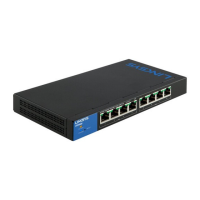52
Table of Contents
Linksys
• Alternate—The interface provides an alternate path to the root
device from the root interface.
• Backup—The interface provides a backup path to the designated
port path toward the Spanning Tree leaves. Backup ports occur
when two ports are connected in a loop by a point-to-point link.
Backup ports also occur when a LAN has two or more established
connections to a shared segment.
• Disabled—The interface does not participate in the Spanning Tree.
• Boundary—The port on this instance is a boundary port. It inherits
its state from instance 0 and can be viewed on the STP Interface
Settings page.
• Mode—Displays the current interface Spanning Tree mode.
• If the link partner is using MSTP or RSTP, the displayed port mode
is R S T P.
• If the link partner is using STP, the displayed port mode is STP.
• Type—Displays the MST type of the port.
• Boundary—A Boundary port attaches MST bridges to a LAN in
a remote region. If the port is a boundary port, it also indicates
whether the device on the other side of the link is working in RSTP or
STP mode.
• Internal—The port is an internal port.
• Designated Bridge ID—Displays the ID number of the bridge that
connects the link or shared LAN to the root.
• Designated Port ID—Displays the Port ID number on the designated
bridge that connects the link or the shared LAN to the root.
• Designated Cost—Displays the cost of the port participating in the
STP topology. Ports with a lower cost are less likely to be blocked if STP
detects loops.
• Remain Hops—Displays the hops remaining to the next destination.
• Forward Transitions—Displays the number of times the port has changed
from the Forwarding state to the Blocking state.
STEP 4 Select an interface, and click Edit.
STEP 5 Enter the parameters.
STEP 6 Click Apply. The Running Configuration file is updated.

